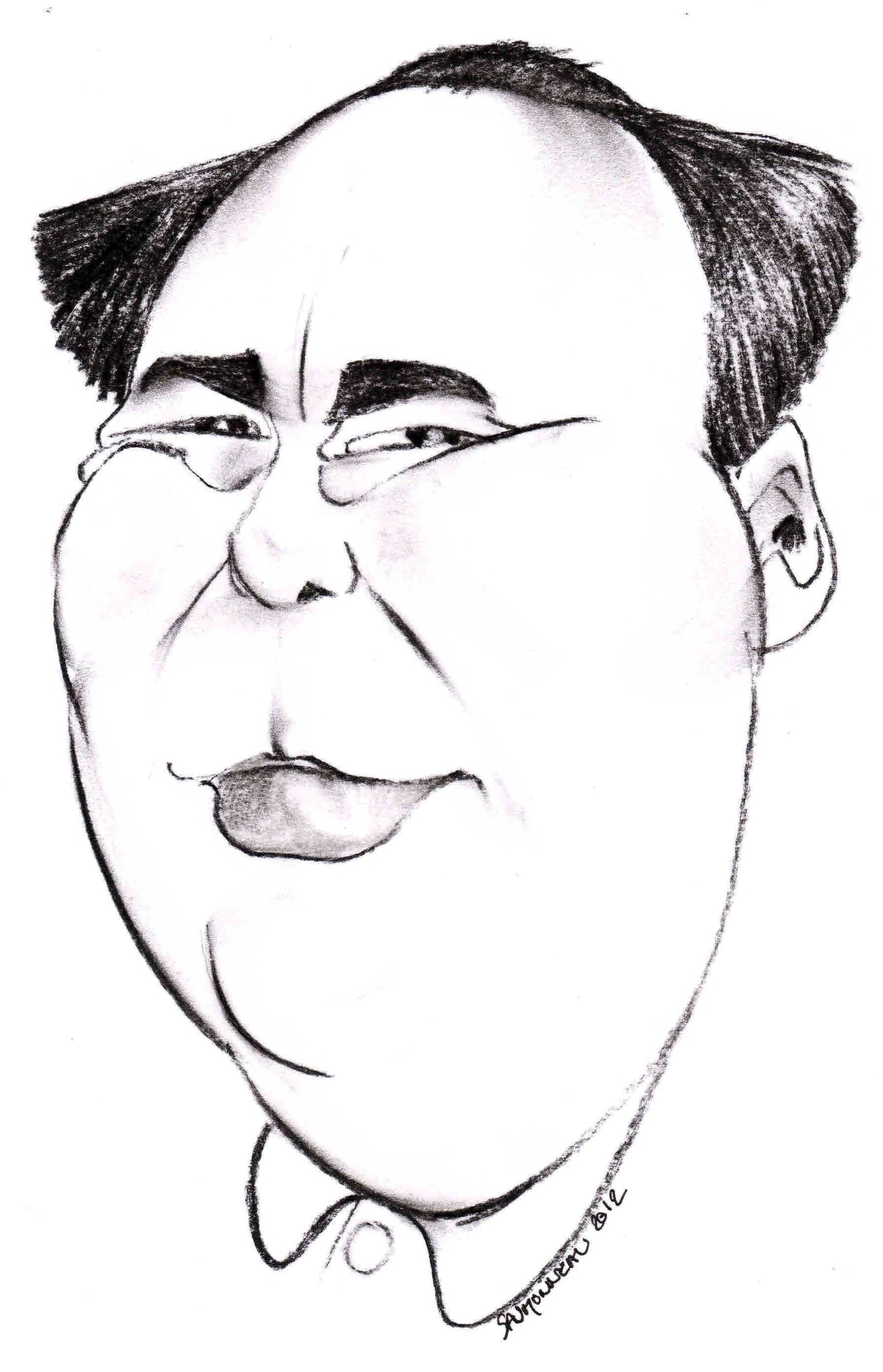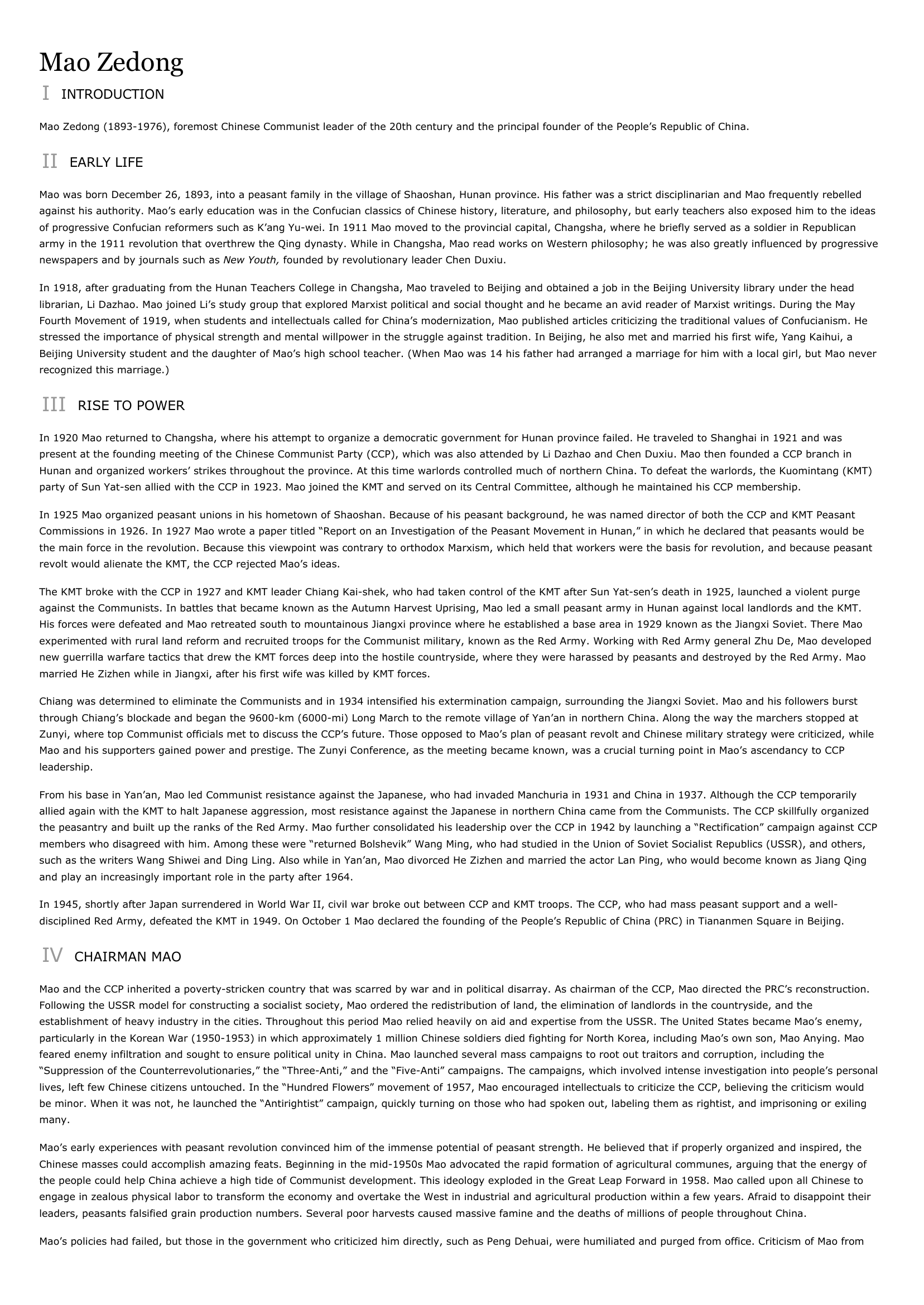Mao Zedong
Publié le 10/04/2019
Extrait du document

Fondateur de la république populaire
Alors qu'il est encore élève à l'école secondaire, Mao Zedong se rallie à la cause républicaine et rejoint en 1911 l'armée révolutionnaire de Sun Yat-sen. L'acceptation des revendications japonaises au traité de Versailles fragilise la situation de la Chine et incite Mao à se tourner vers le marxisme et à participer à la fondation du Parti communiste chinois, tout en conservant des liens étroits avec Sun Yat-sen et le Guomindang, soutenu par l'Union soviétique. En 1924, Mao compte ainsi parmi les principaux membres du comité exécutif du Guomindang. Lorsque le Guomindang sous la direction de Tchang Kaï-chek exclut les communistes du parti nationaliste et écrase le mouvement révolutionnaire à Shanghai et Canton, Mao rejoint les monts du Jinggang, où il organise une république soviétique. Menacé par les attaques du Guomindang, il tente une retraite vers le nord-ouest. C'est le début de la Longue Marche à travers la Chine. Interrompue pour faire face à l'ennemi commun japonais, la guerre civile opposant le Guomindang et les communistes reprend en 1945 et aboutit en 1949 à la victoire des forces de Mao.

«
Mao Zedong
I INTRODUCTION
Mao Zedong (1893-1976), foremost Chinese Communist leader of the 20th century and the principal founder of the People’s Republic of China.
II EARLY LIFE
Mao was born December 26, 1893, into a peasant family in the village of Shaoshan, Hunan province.
His father was a strict disciplinarian and Mao frequently rebelledagainst his authority.
Mao’s early education was in the Confucian classics of Chinese history, literature, and philosophy, but early teachers also exposed him to the ideasof progressive Confucian reformers such as K’ang Yu-wei.
In 1911 Mao moved to the provincial capital, Changsha, where he briefly served as a soldier in Republicanarmy in the 1911 revolution that overthrew the Qing dynasty.
While in Changsha, Mao read works on Western philosophy; he was also greatly influenced by progressivenewspapers and by journals such as New Youth, founded by revolutionary leader Chen Duxiu.
In 1918, after graduating from the Hunan Teachers College in Changsha, Mao traveled to Beijing and obtained a job in the Beijing University library under the headlibrarian, Li Dazhao.
Mao joined Li’s study group that explored Marxist political and social thought and he became an avid reader of Marxist writings.
During the MayFourth Movement of 1919, when students and intellectuals called for China’s modernization, Mao published articles criticizing the traditional values of Confucianism.
Hestressed the importance of physical strength and mental willpower in the struggle against tradition.
In Beijing, he also met and married his first wife, Yang Kaihui, aBeijing University student and the daughter of Mao’s high school teacher.
(When Mao was 14 his father had arranged a marriage for him with a local girl, but Mao neverrecognized this marriage.)
III RISE TO POWER
In 1920 Mao returned to Changsha, where his attempt to organize a democratic government for Hunan province failed.
He traveled to Shanghai in 1921 and waspresent at the founding meeting of the Chinese Communist Party (CCP), which was also attended by Li Dazhao and Chen Duxiu.
Mao then founded a CCP branch inHunan and organized workers’ strikes throughout the province.
At this time warlords controlled much of northern China.
To defeat the warlords, the Kuomintang (KMT)party of Sun Yat-sen allied with the CCP in 1923.
Mao joined the KMT and served on its Central Committee, although he maintained his CCP membership.
In 1925 Mao organized peasant unions in his hometown of Shaoshan.
Because of his peasant background, he was named director of both the CCP and KMT PeasantCommissions in 1926.
In 1927 Mao wrote a paper titled “Report on an Investigation of the Peasant Movement in Hunan,” in which he declared that peasants would bethe main force in the revolution.
Because this viewpoint was contrary to orthodox Marxism, which held that workers were the basis for revolution, and because peasantrevolt would alienate the KMT, the CCP rejected Mao’s ideas.
The KMT broke with the CCP in 1927 and KMT leader Chiang Kai-shek, who had taken control of the KMT after Sun Yat-sen’s death in 1925, launched a violent purgeagainst the Communists.
In battles that became known as the Autumn Harvest Uprising, Mao led a small peasant army in Hunan against local landlords and the KMT.His forces were defeated and Mao retreated south to mountainous Jiangxi province where he established a base area in 1929 known as the Jiangxi Soviet.
There Maoexperimented with rural land reform and recruited troops for the Communist military, known as the Red Army.
Working with Red Army general Zhu De, Mao developednew guerrilla warfare tactics that drew the KMT forces deep into the hostile countryside, where they were harassed by peasants and destroyed by the Red Army.
Maomarried He Zizhen while in Jiangxi, after his first wife was killed by KMT forces.
Chiang was determined to eliminate the Communists and in 1934 intensified his extermination campaign, surrounding the Jiangxi Soviet.
Mao and his followers burstthrough Chiang’s blockade and began the 9600-km (6000-mi) Long March to the remote village of Yan’an in northern China.
Along the way the marchers stopped atZunyi, where top Communist officials met to discuss the CCP’s future.
Those opposed to Mao’s plan of peasant revolt and Chinese military strategy were criticized, whileMao and his supporters gained power and prestige.
The Zunyi Conference, as the meeting became known, was a crucial turning point in Mao’s ascendancy to CCPleadership.
From his base in Yan’an, Mao led Communist resistance against the Japanese, who had invaded Manchuria in 1931 and China in 1937.
Although the CCP temporarilyallied again with the KMT to halt Japanese aggression, most resistance against the Japanese in northern China came from the Communists.
The CCP skillfully organizedthe peasantry and built up the ranks of the Red Army.
Mao further consolidated his leadership over the CCP in 1942 by launching a “Rectification” campaign against CCPmembers who disagreed with him.
Among these were “returned Bolshevik” Wang Ming, who had studied in the Union of Soviet Socialist Republics (USSR), and others,such as the writers Wang Shiwei and Ding Ling.
Also while in Yan’an, Mao divorced He Zizhen and married the actor Lan Ping, who would become known as Jiang Qingand play an increasingly important role in the party after 1964.
In 1945, shortly after Japan surrendered in World War II, civil war broke out between CCP and KMT troops.
The CCP, who had mass peasant support and a well-disciplined Red Army, defeated the KMT in 1949.
On October 1 Mao declared the founding of the People’s Republic of China (PRC) in Tiananmen Square in Beijing.
IV CHAIRMAN MAO
Mao and the CCP inherited a poverty-stricken country that was scarred by war and in political disarray.
As chairman of the CCP, Mao directed the PRC’s reconstruction.Following the USSR model for constructing a socialist society, Mao ordered the redistribution of land, the elimination of landlords in the countryside, and theestablishment of heavy industry in the cities.
Throughout this period Mao relied heavily on aid and expertise from the USSR.
The United States became Mao’s enemy,particularly in the Korean War (1950-1953) in which approximately 1 million Chinese soldiers died fighting for North Korea, including Mao’s own son, Mao Anying.
Maofeared enemy infiltration and sought to ensure political unity in China.
Mao launched several mass campaigns to root out traitors and corruption, including the“Suppression of the Counterrevolutionaries,” the “Three-Anti,” and the “Five-Anti” campaigns.
The campaigns, which involved intense investigation into people’s personallives, left few Chinese citizens untouched.
In the “Hundred Flowers” movement of 1957, Mao encouraged intellectuals to criticize the CCP, believing the criticism wouldbe minor.
When it was not, he launched the “Antirightist” campaign, quickly turning on those who had spoken out, labeling them as rightist, and imprisoning or exilingmany.
Mao’s early experiences with peasant revolution convinced him of the immense potential of peasant strength.
He believed that if properly organized and inspired, theChinese masses could accomplish amazing feats.
Beginning in the mid-1950s Mao advocated the rapid formation of agricultural communes, arguing that the energy ofthe people could help China achieve a high tide of Communist development.
This ideology exploded in the Great Leap Forward in 1958.
Mao called upon all Chinese toengage in zealous physical labor to transform the economy and overtake the West in industrial and agricultural production within a few years.
Afraid to disappoint theirleaders, peasants falsified grain production numbers.
Several poor harvests caused massive famine and the deaths of millions of people throughout China.
Mao’s policies had failed, but those in the government who criticized him directly, such as Peng Dehuai, were humiliated and purged from office.
Criticism of Mao from.
»
↓↓↓ APERÇU DU DOCUMENT ↓↓↓
Liens utiles
- QUATRE ESSAIS PHILOSOPHIQUES, Mao Zedong ou Mao Tsé-toung (résumé)
- Mao Zedong
- Mao Zedong - historia.
- Cronología: Mao Zedong AÑO ACONTECIMIENTO 1893 Nace el 26 de diciembre, en Shaoshan (Hunan).
- Mao Zedong ou Mao Tsé-toung.

































